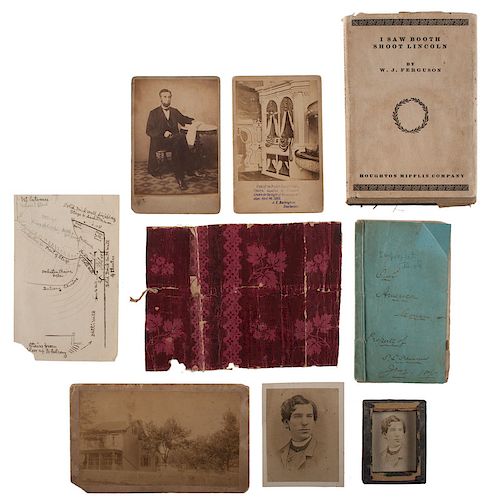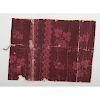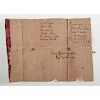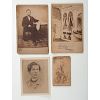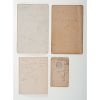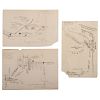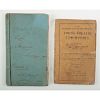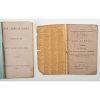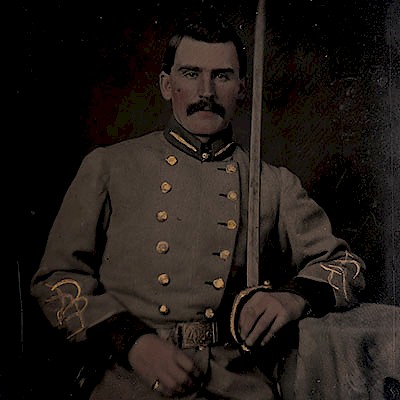William J. Ferguson, Our American Cousin Cast Member, Lincoln Assassination Archive
About Seller
6270 Este Ave.
Cincinnati , OH 45232
United States
With offices in Cincinnati, Cleveland and Denver, Cowan’s holds over 40 auctions each year, with annual sales exceeding $16M. We reach buyers around the globe, and take pride in our reputation for integrity, customer service and great results. A full-service house, Cowan’s Auctions specializes in Am...Read more
Two ways to bid:
- Leave a max absentee bid and the platform will bid on your behalf up to your maximum bid during the live auction.
- Bid live during the auction and your bids will be submitted real-time to the auctioneer.
Bid Increments
| Price | Bid Increment |
|---|---|
| $0 | $25 |
| $500 | $50 |
| $1,000 | $100 |
| $2,000 | $250 |
| $5,000 | $500 |
| $10,000 | $1,000 |
| $20,000 | $2,500 |
| $50,000 | $5,000 |
| $100,000 | $10,000 |
About Auction
Jun 22, 2018
Cowan’s American History: Premier Auction, scheduled for June 22, 2018 is comprised of early photographs, documents, manuscripts, broadsides, flags, and more dating from the Revolutionary War, the Civil War, Late Indian Wars, World War I and II and beyond. Cowan's Auctions dawnie@cowans.com
- Lot Description
Lot of items from the personal collection of famed theater actor William J. Ferguson, cast member of Our American Cousin and witness to Lincoln's assassination. This exceedingly rare and unique combination of assassination memorabilia includes a large piece of Presidential Box wallpaper as well as Ferguson's hand drawn diagrams of Ford's Theatre and the path of John Wilkes Booth's escape.
William J. Ferguson (1845-1930) was one of the most well-known actors of the late nineteenth and early twentieth century. In 1865, however, he was just starting his career working as a "call boy" and occasional player at Ford's Theatre. On the night of April 14, 1865, Ferguson was called upon to fill in for another actor who had become ill, and in doing so his life would be forever changed. Standing just off stage beside legendary British actress Laura Keene, Ferguson had a direct line of sight to President Lincoln's box and witnessed the assassination. Booth then passed directly between Keene and Ferguson as he fled the scene.
Either from fear that his southern roots would somehow implicate him in the crime or possibly out of deference to fellow actor Edwin Booth, brother of John Wilkes Booth, Ferguson did not share details of his experience until nearly half a century later. Newspaper and magazine clippings included in this collection indicate that in approximately 1913 Ferguson began discussing the assassination more openly, often in interviews tied to publicity for his roles on stage and screen. Ferguson's definitive account of his recollections from the night of the assassination was published in his 1930 book I Saw Booth Shoot Lincoln. Ferguson's account of the assassination is notable in that it contradicts some long-held assertions about the night of the assassination including that Booth did not pause in his flight to shout "Sic semper tyrannis!" as he crossed the stage.
In his book I Saw Booth Shoot Lincoln, Ferguson writes on pages 58/59, “From the wall where I saw Mr. Lincoln rest his head, I stripped away a length of the red-flowered wall-paper." Measuring approximately 9.25 x 7 in., the piece of Presidential Box wallpaper in this collection is much larger than that described by Ferguson in his book, a discrepancy that cannot be completely explained. The wallpaper is deep red with a vertical floral stripe pattern alternated with lighter red leaves on stems. Pattern matches samples shown on websites of Ford’s Theatre and the Lincoln Financial Foundation Collection. Verso has hand written ink notation “Wall Paper from off the spot on Wall where his head rested when shot” and “President Lincoln’s Box Ford’s Theatre Washington D.C. U. S. {April 14, 1865}/Wm. J. Ferguson Eye Witness.” Paper is very worn along creases and in some places fragments of the pattern are completely removed from the textile backing, however, pattern color remains vibrant and pattern is clearly visible. Wallpaper remnants from assassination are relatively rare at auction, and the larger size of this fragment makes it unusual.
Also included with the collection are Ferguson's three hand drawn diagrams of Ford's Theatre and Booth's movements on the night of Lincoln's assassination. These never before published diagrams will no doubt add to the discussion and even controversy which still surround the aftermath of the assassination, particularly with regard to John Wilkes Booth's flight from the theatre and Laura Keene's path to the Presidential Box.
Diagram 1 is titled “How Booth escaped follow the darts” and is signed “Wm. J. Ferguson” with notation on top left that reads “These Dimensions are correct This plan has never been published The interior of theater was demolished soon after assassination.” Diagram shows Lincoln’s view of the stage from the President’s Box and “darts” or arrows show how Ferguson viewed Booth’s escape across the stage, through the back hallway, and out the back door into the alley. Measures approx. 7.75 x 5.75 in. Diagram drawn on blue lined paper. Slightly toned. Creased at folds, minor soil along edge lines, minor loss top left edge line not affecting text. Overall good condition.
Diagram 2 is titled “Plan of the Box” signed “Wm. J. Ferguson” featuring the layout of the President’s Box, the exterior hallway from which Booth entered the box, and the 1st Entrance where Ferguson stood at the time of the assassination. Measures approx. 7.75 x 5 1/8 in. Slightly toned. Creased at folds. A few very small spots of soil. Good condition.
Diagram 3 is Ferguson’s drawing of the theater walls, Lincoln’s box, as well as “Stairs from floor up to balcony,” “Booth’s Walk,” “Gimlet Hole in Door,” “Front of Stage,” “Line of escape,” and the “1st Entrance where I stood.” Ferguson’s note on verso reads “President Lincoln’s Box at Fords Theatre Washn D C Apl 14th 1865 Propy of Wm J Ferguson.” Measures 7.75 x 5 1/8 in. Slightly toned. Small amount of soiling in isolated spots. Loss on bottom left corner slightly affecting word “floor.” Overall good condition.
Exact dates the diagrams were made are unclear. Ferguson’s own book did not include his diagrams of the theater, instead it included the formally rendered “Diagram of the Stage of Ford’s Theater at the Time of Lincoln’s Assassination” taken from Benn Pitman’s The Assassination of President Lincoln and the Trial of the Conspirators (1865).
Accompanying the wallpaper and the diagrams are early twentieth century newspaper clippings and magazine articles featuring Ferguson's accounts of the assassination as well as a variety of other items related to the assassination. These include the following publications and documents:
Sketches of Tudor Hall and the Booth Family by Ella V. Mahoney, Baltimore: Franklin Printing Co., 1925. Inscribed by the author Ella V. Mahoney on interior front cover page with the note “Very Sincerely Yours in the name of truth and justice/ The author/ Ella V. Mahoney.” Includes Tudor Hall pamphlet “Visit the Birthplace of Edwin Booth and John Wilkes Booth.”
I Saw Booth Shoot Lincoln by W. J. Ferguson, Boston & New York: Houghton Mifflin, 1930. First edition. Hardcover book inscribed on inside cover "Enid Schenk The Author Enid’s Great Grandfather." Also another copy of same book with original wrapping.
Two typescript drafts of Ferguson's assassination memoir both with handwritten edits. One version includes the book’s original title Lincoln’s Assassination as Seen by Actor W. J. Ferguson which was scratched out in pencil and replaced with the final title I SAW BOOTH SHOOT LINCOLN.
Typed 3pp manuscript titled “On the Assassination of Lincoln” describing an interview the author did with Ferguson and his eyewitness account of the assassination; top pencil note reads “To Geo Henry Trader,” notes that Laura Keene’s dress was bloody from Booth’s cut hand not Lincoln’s blood.
An issue of The American Magazine, August 1920, Vol. XC, No. 2, featuring the article “I Saw Lincoln Shot! And here is my story – told now for the first time” by William J. Ferguson. Editor note indicates that this is the first time Ferguson's version of the night’s events had ever been published.
An 11pp document, handwritten in pencil, with headline “Was President Lincoln’s Box Prepared For His Assassination by Booth or Spangler. Testimony Relating to John Wilkes Booth And Circumstances Attending the Assassination. These extracts were taken from a book (64 years old & out of print) by Benn Pittman Recorder to the US Commission at the trial of the conspirators at Washington D.C.”
Our American Cousin imperfect play book printed in 1869. Appears to be missing pages at end. Handwritten on front cover is name of play and "Property of S. L. [?] Sausinis [?]" and 1875.
The Rivals incomplete playbook, ends at page 70. Possible signature of John T. Ford on front cover; hand stamped "FORD’S THEATRE" on front cover.
A small number of postcards and nine photographs complete the archive. There are four rare photographs of William J. Ferguson in his younger years, including a CDV (somewhat faded) which was hand stamped on verso December 25, 1866, approximately a year and half after the assassination. Also included is a period copy Lincoln photograph, one of a series of 6 images taken by Alexander Gardner, Aug 9, 1863, prior to opening of Gardner’s Gallery in DC. A very rare image in which Lincoln holds a newspaper and his eyeglasses, designated O-70 by Ostendorf. Finally, there are two photographs of an unidentified house, a reproduced photograph of a Lincoln oil portrait, and a reproduction photograph showing the interior of Ford’s Theater, stamped at the bottom “View of the Private Box of Ford’s Theatre, occupied by President Lincoln on the night of his assassination, April 14, 1865./ J. E. Buckingham, Doorkeeper.” Verso reads “Property of WJ Ferguson.”
This collection of Lincoln assassination artifacts and memorabilia has come to Cowan's Auctions from a direct descendant of assassination witness William J. Ferguson, and includes a notarized statement from the consignor stating how the items came to be in her possession. The lot also includes a certificate of authenticity from theatre historian Thomas A. Bogar, PhD., who authored the book Backstage at the Lincoln Assassination.
Provenance: Descended directly through Ferguson family.Eliminate the Hassle of Third-Party Shippers: Let Cowan's Ship Directly To You!Condition
If you'd like a shipping estimate before the auction, contact Cowan's in-house shipping department at shipping@cowans.com or 513.871.1670 x219. - Shipping Info
-
Buyers are required to pay for all packing, shipping and insurance charges. Overseas duty charges are the responsibility of the successful Bidder. Be aware that for larger and/or valuable items, shipping charges can be substantial. - If there is no shipping amount on listed your invoice, you will need to make arrangements to pick up or ship your purchase through an alternative shipping company. Our shipping department can be contacted at 513.871.1670 (ext. 219) or email shipping@cowans.com. - Shipping charges include insurance for your order while in transit. If you have private insurance we will adjust your charge to include only packing and shipping. - Please allow 14 – 21 days after payment to package and ship your purchase as carefully as possible.
-
- Buyer's Premium



 EUR
EUR CAD
CAD AUD
AUD GBP
GBP MXN
MXN HKD
HKD CNY
CNY MYR
MYR SEK
SEK SGD
SGD CHF
CHF THB
THB